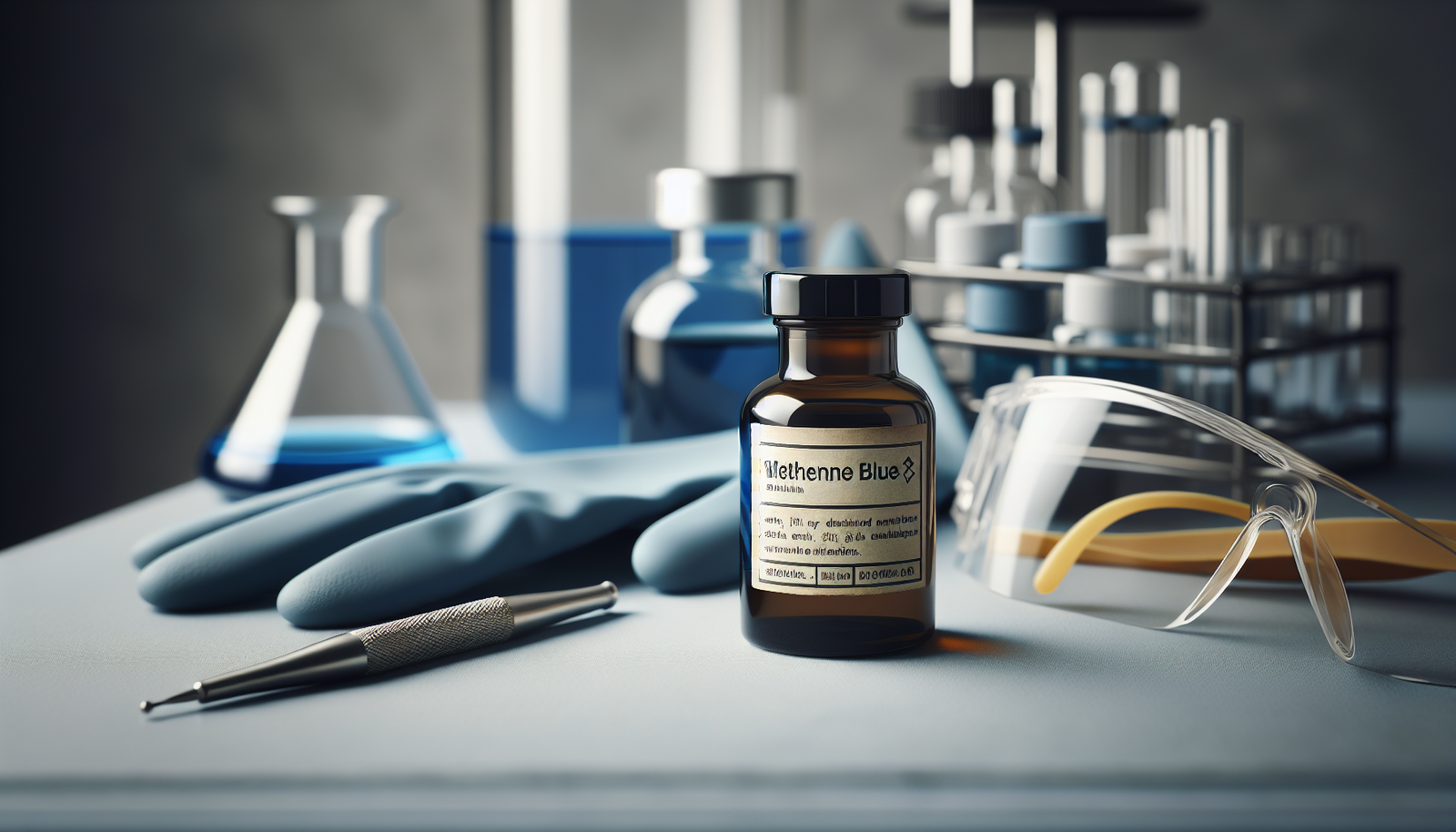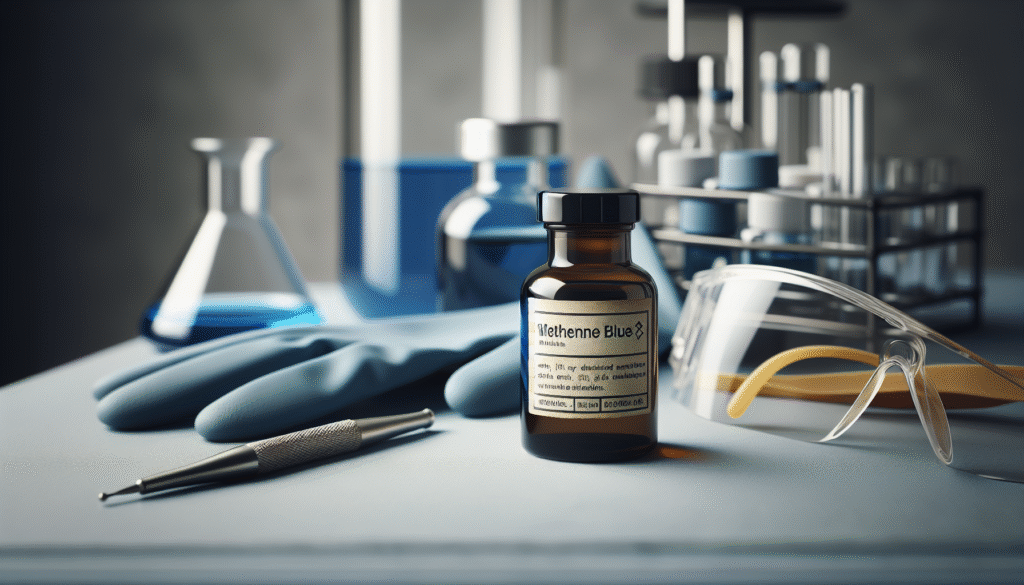
Have you ever considered the importance of storing chemicals, particularly methylene blue, in a way that ensures both safety and integrity? Proper storage is crucial not only for maintaining the efficacy of chemicals but also for safeguarding your health and the environment. Understanding how to handle and store methylene blue can make a significant difference in various applications, from laboratory settings to medical uses.
Understanding Methylene Blue
Methylene blue is a synthetic dye with a rich history, used across various fields, including biology, chemistry, and medical sciences. Primarily, it serves as a redox indicator, a medication for methemoglobinemia, and a vital stain in several microbiological applications. To ensure its efficacy, how you store methylene blue is imperative.
Chemical Properties of Methylene Blue
Before delving into storage methods, it is essential to recognize the properties of methylene blue:
- Chemical Formula: C16H18ClN3S
- Appearance: Dark blue powder or dark blue solution
- Melting Point: Approximately 100-102 °C (212-216 °F)
- Solubility: Soluble in water and slightly in alcohol
- Stability: Sensitive to light and can degrade in inappropriate conditions
These characteristics dictate the conditions under which you should store methylene blue to maintain its quality.
Why Proper Storage is Necessary
When stored improperly, methylene blue can degrade, leading to a loss of potency and possibly to the formation of hazardous byproducts. Proper storage practices can mitigate these risks and extend the shelf life of the compound.
Risks of Inadequate Storage
Failing to store methylene blue correctly can result in:
- Degradation: Exposure to light or heat can cause the methylene blue solution to break down, affecting its effectiveness.
- Contamination: Poor storage practices may lead to contamination, compromising the solution’s integrity.
- Health Hazards: Methylene blue may pose health risks, including allergy and toxicity in certain conditions, making proper handling critical.
Understanding these risks emphasizes the significance of establishing a reliable storage protocol.

Conditions for Storing Methylene Blue
When it comes to the storage environment, several critical factors come into play, including temperature, light exposure, and humidity levels. By adhering to these conditions, you can optimize the storage of your methylene blue.
Temperature Control
Methylene blue should ideally be stored at a stable, cool temperature. The recommended storage temperature typically ranges between 15 °C to 25 °C (59 °F to 77 °F). Avoid exposing the chemical to extreme temperature fluctuations that can promote degradation.
Table 1: Recommended Temperature Ranges
| Temperature Range | Comments |
|---|---|
| 15 °C – 25 °C | Ideal for storage |
| Below 15 °C | May not be effective |
| Above 25 °C | Increases degradation risk |
Light Exposure
Light can significantly affect the stability of methylene blue. Choose a storage location that minimizes exposure to both natural and artificial light.
Light-Proof Containers
Opt for light-proof or amber-colored glass containers that can protect the solution from damaging light. Performing periodic checks on the containers can help ensure the integrity of the dye remains intact.
Humidity Control
High humidity can lead to condensation inside storage containers, which can dilute the chemical and promote the growth of mold. Methylene blue should ideally be stored in a dry environment.
Use of Desiccants
In addition to selecting a low-humidity area, consider using desiccants such as silica gel packets within containers to absorb any moisture that may accumulate.
Selecting Storage Containers
The choice of proper storage containers is paramount when it comes to maintaining the stability of methylene blue. Two main factors to consider are the material used for the container and the container’s sealing mechanism.
Material Considerations
Methylene blue should be stored in containers made of materials that do not react adversely with the chemical.
Recommended Materials
- Amber Glass: These containers provide excellent protection against light exposure.
- HDPE Plastic: High-density polyethylene is resistant to most chemicals and is a good option for longer-term storage.
Sealing the Container
Ensure that the containers are sealed properly to prevent air exchange, which can introduce contaminants and encourage oxidation.
Table 2: Container Sealing Options
| Type | Comments |
|---|---|
| Screw cap | Provides a secure seal |
| Stopper with paraffin seal | Offers an extra layer of protection against air and moisture |

Labeling the Storage Containers
Once you have chosen the appropriate container, clear and accurate labeling is crucial. Labeling not only provides essential information for future reference but also enhances safety by alerting others to the chemical stored within.
Essential Information to Include
Your labels should include the following:
- Chemical Name: Clearly label the container with “Methylene Blue.”
- Concentration: Include the concentration of the solution for accurate use.
- Date of Storage: Indicate the date when you stored the chemical for tracking its shelf life.
- Safety Information: Include hazard warnings and essential handling instructions.
Shelf Life and Expiration
Understanding the shelf life of methylene blue is critical for any applications you may have in mind. While it can vary depending on storage conditions, some general guidelines can provide a framework for managing your supply effectively.
Typical Shelf Life
Methylene blue generally has a shelf life of about two to three years when stored properly. However, it is essential to conduct regular checks on the stored chemicals to assess their condition.
Signs of Degradation
You should be alert for any signs that indicate methylene blue has degraded:
- Color Change: Significant fading of the blue color can signify degradation.
- Precipitation: Particulate matter or cloudiness in the solution may indicate instability.
- Unusual Odor: Any unexpected smell could be a warning that the chemical has broken down.
Disposal of Methylene Blue
Proper disposal of methylene blue is essential for both safety and environmental considerations. Adhering to local regulations regarding hazardous materials is crucial.
Steps for Safe Disposal
- Consult Local Regulations: Identify guidelines for disposing of hazardous chemicals in your area.
- Avoid Drains: Never dispose of methylene blue down the drain as it may pollute water sources.
- Use Designated Containers: Utilize designated hazardous waste containers for safe transport to disposal facilities.
Safety Precautions When Handling Methylene Blue
When working with methylene blue, safety should be your top priority. Adopting effective safety measures will reduce the risk of accidental exposure or contamination.
Personal Protective Equipment (PPE)
Utilizing appropriate personal protective equipment is vital for ensuring safety. Your PPE should typically include:
- Gloves: Use nitrile gloves to protect your hands from direct exposure.
- Goggles: Safety goggles can protect your eyes from splashes during handling.
- Lab Coat: A lab coat will also safeguard your skin and clothing.
First Aid Measures
In case of accidental exposure, familiarize yourself with the first aid measures for methylene blue:
- Skin Contact: Rinse the affected area with plenty of water and remove contaminated clothing.
- Eye Contact: Flush the eyes with water for at least 15 minutes and seek medical attention.
- Inhalation: Move the individual to fresh air immediately. If breathing is difficult, seek medical help.
Conclusion
Storing methylene blue safely relies heavily on understanding its properties, selecting appropriate containers, and adhering to environmental conditions. By following the guidelines outlined in this article, you significantly reduce the chances of degradation, contamination, or accidents. Consider establishing a routine for monitoring your supplies to ensure safety and efficacy in your applications. Methylene blue can serve various purposes effectively, provided that you take the necessary precautions to maintain its quality.
Understanding how to store methylene blue not only ensures the compound remains viable for its intended uses but also upholds your commitment to safety and responsible handling in any environment.